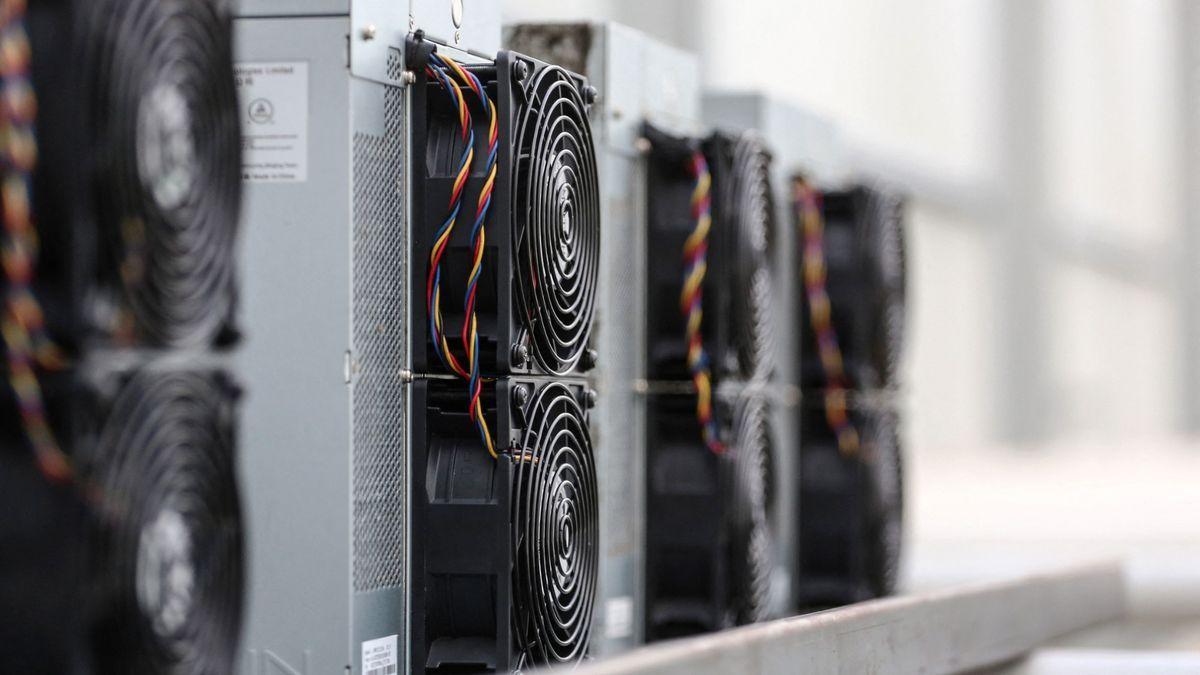Bitcoin Miners Pivot to AI: The Shift from Crypto to Artificial Intelligence
4 Sources
4 Sources
[1]
Bitcoin miners are ditching crypto for the more profitable AI
The Bitcoin mining reward has been reduced after Bitcoin halving, and that's driving some companies to shift from Bitcoin mining centers to artificial intelligence data centers. In a recent interview with CNBC, Houston-based tech company Lancium and Denver-based Crusoe Energy Systems announced a multibillion-dollar deal to build a 200-megawatt data center just outside Abilene, Texas. The new center is designed to meet the unique needs of AI companies, and it marks a departure for the two firms, which have raised hundreds of millions in recent years for Bitcoin mining infrastructure. The first phase of the Abilene facility represents a small portion of a larger 1.2-gigawatt expansion plan. Lancium President Ali Fenn stated in an interview with CNBC that once fully operational, this will stand as one of the world's largest artificial intelligence data center campuses. This development serves as the latest evidence of the increasing pace of the shift towards AI infrastructure, leaving Bitcoin mining in the rearview. "Data centers are rapidly evolving to support modern AI workloads, requiring new levels of high-density rack space, direct-to-chip liquid cooling and unprecedented overall energy demands," Chase Lochmiller, Crusoe's co-founder and CEO told CNBC. Bitcoin went through a significant technical event earlier this year called the 'Bitcoin halving.' This event reduced the reward for mining new Bitcoin by half. As a result of the halving, Bitcoin miners' rewards for creating Bitcoin decreased from 6.25 Bitcoin to 3.125 Bitcoin. The Bitcoin halving was built into Bitcoin's code from the beginning to ensure scarcity and safeguard against inflation. However, following this event, some Bitcoin miners are finding it challenging to remain profitable using older Bitcoin mining equipment and are now looking into other business opportunities. Bitcoin mining and AI infrastructure businesses share some similarities. Bitcoin mining companies operate extensive data centers that require energy consumption, hardware optimization, cooling, and technological advancements. As the AI industry continues to grow and requires more capacity and Bitcoin miners seek new ways of generating and diversifying income, AI becomes a seemingly secure option for them. Earlier this year, Bitcoin miners like Core Scientific and Hut 8 invested millions in expanding their AI business and building out data center portfolios for AI.
[2]
Bye-bye bitcoin, hello AI: Texas miners leave crypto for next new wave
Cattle graze at the Buffalo Gap Wind Power project in Taylor and Nolan counties just south of Abilene, Texas, in 2016.Robert Daemmrich / Corbis via Getty Images file Just off of Interstate 20, in the heart of West Texas, is a town of 125,000 people called Abilene. Once a stopping point along a cross-country cattle trail in the days of the American Old West, the small outpost is now getting into the burgeoning artificial intelligence business. Houston-based tech company Lancium and Denver-based Crusoe Energy Systems announced on Thursday morning a multibillion-dollar deal to build a 200-megawatt data center just outside Abilene that is designed to "meet the unique needs of AI companies" -- such as enabling advanced cloud computing for applications like medical research and aircraft design. It is the first phase of a larger 1.2-gigawatt build-out. Lancium President Ali Fenn told CNBC that at full capacity, this will be one of the largest AI data center campuses in the world, in the latest example that the race to power AI -- and leave bitcoin mining behind -- is accelerating. "Data centers are rapidly evolving to support modern AI workloads, requiring new levels of high-density rack space, direct-to-chip liquid cooling and unprecedented overall energy demands," said Chase Lochmiller, Crusoe's co-founder and CEO. There are a lot of synergies between the bitcoin mining and AI infrastructure businesses. Mining firms have expansive data centers, with access to fiber lines and large amounts of power across the U.S. They're exactly the types of facilities needed for compute-intensive AI operations, which means their sites and technology are in high demand. Meanwhile, miners need to diversify. Following the bitcoin halving in April, an event that happens about once every four years, the business of generating new tokens has become much less profitable. JPMorgan Chase analysts wrote in a report in June that "some operators are feeling the financial pinch from the recent block reward halving, which cut industry revenues in half, and are actively exploring exit strategies." With the burgeoning AI industry in need of capacity and bitcoin miners in search of new ways to generate returns on their hefty investments, mergers, financings and partnerships are rapidly coming together. Lancium and Crusoe join a long list of miners looking to trade bitcoin for artificial intelligence, and so far, the strategy appears to be working. The combined market capitalization of the 14 major U.S.-listed bitcoin miners tracked by JPMorgan hit a record high of $22.8 billion on June 15 -- adding $4.4 billion in just two weeks, according to a June 17 research note from the bank. Bit Digital, a bitcoin miner that now derives an estimated 27% of its revenue from AI, said in June that it had entered into an agreement with a customer to supply Nvidia GPUs over three years at a data center in Iceland, in a deal that is expected to generate $92 million in annual revenue. It's paying for the general processing units, in part, by liquidating some of its crypto holdings.
[3]
Bye-bye bitcoin, hello AI: Texas miners leave crypto for next new wave
For years, Crusoe's work has been virtually synonymous with the bitcoin mining industry. Crusoe's technology helps oil companies to turn wasted energy, or flare gas, into a useful resource. Many bitcoin miners, with the help of Crusoe, have set up machines adjacent to these sites in order to capitalize on this cheaper power source. Starting in 2021, for example, ExxonMobil began working with Crusoe to mine bitcoin in North Dakota. But Crusoe's Lochmiller told CNBC that AI infrastructure has actually been part of the vision since the company's founding six years ago. "We're reimagining AI infrastructure from the ground up - from our energy solutions, to the design, engineering and building of our specially-designed AI data centers, to our manufacturing capabilities with Crusoe Industries for key electrical data center infrastructure and ultimately to our purpose-built AI computing stack," he said. The facility in Abilene, which is expected to go live in 2025, is also planning to draw primarily from renewable energy sources. "Our power orchestration technology is positioned to ensure that mega-scale AI data center campuses can be assets to the grid, not liabilities," Lancium's Fenn told CNBC. Lancium has patented technology that allows it to turn the demand of energy buyers into a sort of dial that can be incrementally turned up or down in as little as five seconds. This helps to balance out a power grid that has inherently volatile energy sources like wind and solar power. "Lancium's original vision was to bring large-scale loads to locations with the best, abundant renewable energy in order to facilitate the energy transition," said Fenn. Back in 2018, Fenn says that the only load that was a good fit for this was bitcoin mining. One of bitcoin's greatest features is that it is totally location agnostic. Miners only require a power source and an internet connection, unlike other industries that must be relatively close to their end users. In some cases, the built-in proceeds from minting cryptocurrency have offered enough of a financial incentive to make it worth it to build the infrastructure necessary to harness previously untapped sources of power -- especially in Texas, which is known for being a mecca for renewable energy sources like wind and solar. Bitcoin miners are also flexible electricity consumers -- essentially, they function as buyers who will take as much power as they're given, whatever the time of day, and are just as willing to power down with a few seconds' notice. But Lancium's strategy has since shifted to AI. "Traditional data centers were - and still are - optimized principally for proximity to urban areas and users," said Fenn. "That has all changed now, with AI data centers optimized for massive scale energy availability, cost, and greenness. Our vision, campuses, and technology are perfectly positioned for this significantly larger, expanded opportunity."
[4]
Struggling bitcoin miners seek deals with AI companies
London | Bitcoin miners are rushing to sign deals with artificial intelligence developers in a bid to revive their flagging revenues by finding new customers for their vast data centres. Crypto miners run powerful computing sites, often covering acres of land, where they solve complex mathematical puzzles to authenticate transactions and produce digital coins. But with high energy and computing costs, and with the rewards for mining having recently halved, many are struggling to turn a profit.
Share
Share
Copy Link
Bitcoin miners are abandoning cryptocurrency operations in favor of more profitable AI ventures. This shift is particularly noticeable in Texas, where miners are repurposing their infrastructure to meet the growing demand for AI computing power.

The Great Shift: From Bitcoin to AI
In a significant turn of events, bitcoin miners are increasingly abandoning their cryptocurrency operations in favor of more lucrative artificial intelligence (AI) ventures. This trend is particularly pronounced in Texas, where the once-booming crypto mining industry is now pivoting to meet the surging demand for AI computing power
1
.Economic Drivers Behind the Transition
The shift is primarily driven by economic factors. Bitcoin mining profitability has been on a decline, with the cryptocurrency's value fluctuating and energy costs remaining high. In contrast, the AI industry is experiencing explosive growth, creating a high demand for computing power. This demand has made AI-related services more profitable than traditional crypto mining
2
.Repurposing Infrastructure
Bitcoin miners are finding that their existing infrastructure can be repurposed for AI applications with relative ease. The high-powered computers and extensive data centers used for crypto mining are well-suited for the computational needs of AI processes. This adaptability allows miners to transition their operations without the need for significant additional investment
3
.Texas: The New AI Frontier
Texas, once a hotbed for cryptocurrency mining due to its relatively cheap electricity and favorable regulations, is now becoming a hub for AI computing. The state's energy grid, which had been strained by crypto mining operations, is now being utilized for AI applications. This shift is welcomed by local authorities and energy providers, as AI computing tends to have a more predictable and manageable power consumption pattern
2
.Industry Partnerships and Deals
As part of this transition, former crypto mining companies are actively seeking partnerships with AI firms. These deals often involve providing computing power and infrastructure to support AI operations. For instance, some miners are offering their GPU clusters to AI companies for training large language models, a crucial component in the development of advanced AI systems
4
.Related Stories
Impact on the Crypto Mining Landscape
The exodus of miners from bitcoin to AI is having a noticeable impact on the cryptocurrency mining landscape. With fewer miners dedicated to bitcoin, the network's hash rate may be affected, potentially influencing transaction processing times and the overall security of the blockchain. However, some experts argue that this shift might lead to a more sustainable and efficient crypto mining ecosystem in the long run
1
.Future Outlook
As the AI industry continues to grow and evolve, it's likely that more crypto miners will consider making the switch. This trend could reshape the digital infrastructure landscape, with former crypto mining hubs potentially becoming centers for AI innovation and computing. The transition also highlights the adaptability of the tech industry and the interconnectedness of different technological domains in the digital age
3
.References
Summarized by
Navi
[4]
Related Stories
Recent Highlights
1
AI Chatbots Sway Voters More Effectively Than Traditional Political Ads, New Studies Reveal
Science and Research

2
Google AI glasses set to launch in 2026 with Gemini and Android XR across multiple partners
Technology

3
EU Launches Antitrust Probe Into Google's AI Training Practices and Content Usage
Policy and Regulation








